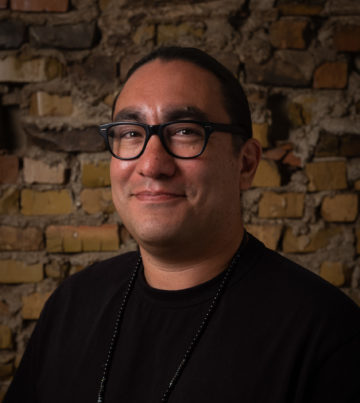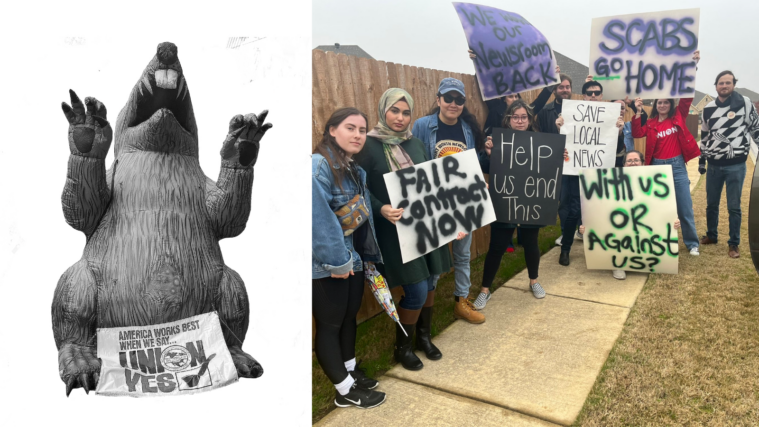
Anatomy of a Crime
How one reporter followed a notorious jailhouse snitch into one of the ugliest parts of the criminal justice system.

Above: Pamela Colloff.
Pamela Colloff’s story “False Witness” may begin like a piece of true crime journalism, but it doesn’t focus on criminal capers and colorful characters solely for the sake of entertainment. Instead, it uses those well-worn elements to transcend the genre. Published by ProPublica and the New York Times Magazine, “False Witness” won the Texas Observer’s MOLLY Investigative Journalism Prize this year, and for good reason. While the story features an unforgettable character involved in a devastating criminal odyssey, it’s also a trenchant look at the criminal justice system’s policies that allow grifters, like Colloff’s main character, to destroy commonly held ideas of justice and public safety. Colloff spoke with the Observer earlier this year at the virtual MOLLY gala about the reporting and writing that went into her story, and how one man’s turn as a repeat jailhouse informant sent dozens of people to jail and death row.
Texas Observer: How did the research for “False Witness” unfold?
Pamela Colloff: “False Witness” was the most document-based story I’ve ever written. Just to give you a sense of things: Paul Skalnik was arrested more than 30 times over the course of 40 years in numerous different states, and he also played a role in over 40 criminal cases during that time. So just being able to talk about one of those cases authoritatively—which means tracking down a trial transcript from decades ago, and the people involved—is a lot of legwork. I was very fortunate that I was able to build on a record that had been compiled, over decades, by attorneys who were litigating the death penalty cases Skalnik testified in.
On top of that, I filed more than 50 public record requests, with varying degrees of success. When I was filing these requests, I called Ken Armstrong, who’s a colleague at ProPublica. Ken did a series for the Chicago Tribune two decades ago that is basically the reason why Illinois no longer has the death penalty. He’s a force, to say the least. I said, “When I’m asking for records from these jails where Skalnik was, what should I be asking for?” He gave me this long list of things that I would never have thought to ask for, like jail logs. I didn’t even know what a jail log was. Ken said, “A jail log will show if and when they took him in and out of the jail, and on what dates.” Skalnik, for instance, had always told this story that he had been taken out of the jail for a conjugal visit in return for his testimony in a particular case, so the jail logs turned out to be hugely important. So knowing what to ask for, and being really precise in these requests, is key.
At what point did you first talk to Skalnik either in person or by phone?
I first went to see him back in 2018, when he was in federal prison. I tried to be my most charming self. My pitch was that he should talk to me about what he had done, because so many years had gone by. I tried to appeal to his vanity because he’s a very vain person and enjoys the limelight. He could not have been more delightful to speak with. That was helpful for me to see because then I understood how people had been conned by him for so long. He promised me that he would tell me everything. We only had an hour together but we agreed to write back and forth after the meeting was over. I was elated. I called my editors and said, “This is going to be incredible. He’s going to tell me everything.” And stupidly—and, again, this helped me understand how people fell victim to him—I didn’t realize I’d been had. He had no intention of telling me anything. For months, I sent him questions and he would reply with, “The mail was down last week, I’m sorry I didn’t see your letter. Can you send it again?” And there are enough problems communicating with anyone in prison that for a while I thought he was telling me the truth.
It took much longer than it should have, frankly, for me to figure out that actually he wasn’t cooperating at all. I ended up maintaining some communication with him as I reported out the story, but I finally pivoted into the documents. And then at the very, very end, when I was all done, I tracked him down to a nursing home in East Texas, where he went after he was released from prison. I paid him a surprise visit. He was shocked that I had found him. I asked him questions for five hours before he kicked me out.
Leading up to that final meeting, what was it like to know him on paper and then spend time with him after being on his trail for so long?
One of the realizations I had while reporting this story is that being the victim of a con artist comes with different baggage than other crimes. These victims experience a lot of shame. And because of that, many of them never go to the police, because they’re too embarrassed, or they blame themselves. That was one of the trickiest things, approaching the people I needed to talk to the right way. I explained that they were not the only ones, and that what happened to them was actually part of a very long pattern that had gone on for decades. Skalnik’s victims had a lot of anger toward him. It wasn’t just the money he took; for a lot of women, he left them with the idea that they couldn’t trust anyone, ever. This was a man who they had married or gotten engaged to, and it was a really painful experience. And then there was the pain that was experienced by the two women who were molested by him.
Let’s talk about that: In the beginning of the story, Skalnik comes off as a kind of quirky, weird con artist. A low-level criminal that’s not necessarily likable, but not necessarily a physical threat. But then we learn about his assault of a 12-year-old girl deeper into the story and the picture becomes very different. I’m curious about why you chose to deliver that information to the reader later in the story?
There were so many discussions with my editors about when to do that reveal. When you really look at who he is, it’s so ugly that if you begin there, you’re going to lose a lot of readers, and I wanted to draw you in and get you engaged with the story. I also thought that by doing that, the reader also experiences, to a slight degree, a little bit of his charm like his victims experienced. I hoped that when you realized just how odious a person he is and what he was doing, that it was more of a sucker punch.
Everybody loves a con man story, but I also wanted to turn that on its head because con man stories are often these fun capers and these are actually very damaging crimes. The main thing that came through in editing, probably the most helpful thing that my editors finally got into my head, is that this isn’t a story about a very clever man who is conning the system. This is about a system that is broken, in which a man like Paul Skalnik can operate to his own benefit and to the benefit of the system. So placing him within that larger systemic framework was what we worked on a lot during the editing.
I read an interview where you talked about editorializing in your writing and specifically the act of stripping emotion and even indignation from your work in order to lay out the facts and connect with readers. Can you talk a little bit more about that?
In 2010, I wrote a story for Texas Monthly about a man named Anthony Graves who had been on death row for 12 years, and behind bars for 18 years, for a crime he didn’t commit. When I started reporting the article, Graves was awaiting a retrial. I spent months trying to understand the case. Finally, I had a true light-bulb moment when I realized that Anthony was innocent; that he, one hundred percent, did not commit this crime. Once I realized that, I don’t think I slept for a couple of months. I wrote in this fugue state. It was very emotional and the draft reflected that. My editors said, “Look, if we just take that emotional language out, you will have a much more powerful story. Let the facts of the case that you’ve laid out here get that reader to that point of outrage.” That was the right call and that was a story that helped bring about justice in his case. But it’s hard sometimes, especially in a case like that, where it’s just so, so clear cut and somebody is incarcerated. It’s horrifying.
I think you’ve also highlighted the difference between a topic and a story. In another interview, you said it took a while for that to click. Can you talk more about that process?
For longform and deeply reported narratives, you must have a character that the reader can get deeply invested in. That character also needs to have a story arc of some kind. I’ve wanted to write a jailhouse informant story for years. I looked at so many interesting cases, but none of them had whatever that magic quality is that really makes a narrative work. Skalnik’s story, though, had everything. He was a jailhouse informant who paid no consequences for what he’d done. In fact, he benefited from lying. And he helped send so many people to prison, and even to death row. Worst of all, Skalnik illustrated what I often couldn’t show with these other stories: When prosecutors let him out over and over again in exchange for his misleading testimony, he went on to commit more crimes and hurt more people, including the girls who he abused. So it had all of the elements of narrative, not just a subject.
And you walk away wondering if there will ever be any consequences for Skalnik or even the police that use people like him to secure convictions.
If you think about it, which is easier? Spending months investigating a really complex, difficult case? Or going to the jail and pulling some guys out of their cells and saying, “Hey, what do you know about this case? Wink, wink.” Right? It’s just such a screwed-up system.
When it comes to influences on your work, is there something in particular that’s informing your writing?
One big influence was the film The Thin Blue Line. It’s a 1988 documentary by Errol Morris. I cannot stress enough what a phenomenal, inspiring piece of work that is. It’s the story of a wrongful conviction in Dallas, and Morris marries his incredible investigation with an artistic sensibility and a Philip Glass soundtrack that is so beautiful. The soundtrack gives the film this atmospheric, foreboding mood. It showed me that you can do really important public interest work while also having an artistic vision. I’d say the other big influence is a 2009 New Yorker article by David Grann called “Trial by Fire.” It’s also about a wrongful conviction and it’s written like a novel. It’s so beautifully written and so engaging and ultimately so devastating. Grann gets at the systemic issues, too. He explores how it’s possible that somebody with such a strong innocence claim was actually executed, and exactly how the system failed.
I haven’t read that story, but I watched the Thin Blue Line again a few months ago, and that influence makes sense to me. I remember the images, like the milkshake, and it feels like you work toward that, like in the Skalnik piece the red velvet curtains in the Dodge van, the zastolen hotel towels and robes, the purple velvet Crown Royal bag, all those details. Are you looking for them or do they just kind of scream out to you so loudly that you can’t ignore them?
I am obsessed with the details and those little bits of color that you just mentioned, because I think they bring a story to life. They also give your work some authority. One of my sources remembered that Paul Skalnik used to steal the towels when he stayed at luxury hotels, even though he was pretending to be a very wealthy man. I love those kinds of details. I’ve found that there are very different types of storytellers and I’m always looking for the sources who have incredibly vivid memories, who can help me really bring a story to life.
This interview has been edited for length and clarity.
Read more from the Observer:
-
The Blacklist: Screened out by automated background checks, tenants who face eviction can be denied housing for years to come.
-
60 Years Ago, San Antonio Teenagers Invented the Westside Sound: Also known as Chicano soul, the Westside Sound blends rock’n’roll with San Antonio roots.
-
Musician Anjimile on Leaving Texas, Getting Sober, and Blowing Up: The Richardson-born singer-songwriter released his debut album in September.


